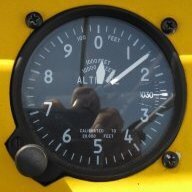-
Posts
425 -
Joined
-
Last visited
-
Days Won
1
Content Type
Profiles
Forums
Gallery
Downloads
Blogs
Events
Store
Aircraft
Resources
Tutorials
Articles
Classifieds
Movies
Books
Community Map
Quizzes
Posts posted by Gentreau
-
-
Probably a good thing for the Jabiru driver that the P51 doesn't have it's 4 Brownings still installed and loaded..........

-
 1
1
-
-
You should get one of those smelling chuckers like wot I got :)
(It dunt do gramma tho)
-
 4
4
-
-
I suspect he is also saving the council all the maintenance costs, as well as paying them $500.Is the leasee a shire coucillor, how else can you lease a $2.5 million council asset for $500 per annum?Guess that would add up to a fairly substantial sum overall....
.
-
Because decimal minutes are sooooooooo 20th century !Why are co-ordinates decimal degrees instead of degrees and decimal minutes like the ERSA?
As do most GIS programmesThat's how Google works...unfortunately.
-
I only ask as I am looking for a reliable source of a geographical database of Australian airports, aerodromes & airstrips.
I would like to have it for offline route planning and conversion to GPS format.
However, if the data's proprietory, I understand.
-
Sorry, I was referring to the airfields database, is that available as a kml or even just a textfile ?
-
Ian, is the base kml/kmz file available for offline use ?
-
So is Blois, but they organised ground marshalling to make it as safe as possible. Take a look at the english blog for details.... Remember this is an uncontrolled aerodrome.http://ulmblois2012.blogspot.fr/2012/07/departures-will-normally-be-from-runway.html
-
So the question has to be asked whether it is appropriate to revert to CTAF rules when there are a lot of aircraft wanting to get away at the same time........After 4pm it was business as usual with alot of aircraft leaving with no control or coordination from ground so ctaf rules apply.....Also, whether it is a good idea to allow the use of multiple entry points onto the active departure runway.
-
Just how 'partial' are you looking for ?
A "bolt on the wings and engine" kit or something less advanced ?
Have you looked at an 80% Spitfire ?
-
Also sounds like a possible traffic management or organisational problem if two aircraft could enter the same runway from different points at a busy time.
-
Thanks very much for sharing that, it's always good to see somebody else's list in case I've overlooked something.Non-Cash CostsOpportunity Cost (6% of $65,000)Depreciation (variable based on hrs)
........
I guess in the case where we borrow the capital, then the interest payments replace the opportunity cost.
I wonder what rate of depreciation you use, as the actual rate seems relatively low for aircraft after the initial "out of the dealership" loss.
My impression is that the longer you operate an aircraft, the less the overall depreciation.
-
Interested to know what's the process and what are the benefits.
Can someone explain ?
-
I'd be very interested to see the calculations, if not the actual figures, to see all the items you've included and how you've calculated/estimated them.We've done detailed figures on both a J170 and a Gazelle. J170 is $150/hour to hire and Gazelle is $135/hour to hire. Costings involved everything including opportunity cost of the funds invested (the calculations were used in cross-hire arrangements). Break-even hours for the Jabiru came at 3.4 hours per week and breakeven for the Gazelle came in at 3.1 hours per week. If you exclude the opportunity cost and depreciation then the break-even was about 1.6 hours for each aircraft. These figures included L2/LAME costs for all maintenance as they're used in the flying school as well as sink funds for engine and prop.Could you share them please ?
-
Look up Polarn fuel transfer pumps. Air pressure, fits on standard jerry-cans, capable of transferring 20ltrs in about a minute.
Example here:
http://www.advantage-motorsport.co.uk/polarn-quick-pump.html
-
I'm interested that some of you say that you don't insure.
What about third party and public liability, isn't that obligatory in Australia ??
-
YOu could also order the same unit from the UK at 1615 GBP which I think is a bit cheaper.
http://www.afeonline.com/shop/product_info.php?products_id=2565
-
-
Two aircraft in inverted formation ?
-
And of course the collective noun for a group of SNAFU's would be a CLUSTERF*CK !
-
 1
1
-
-
Our club rents hangar spaces for 3-axis at 40 Euros per month.
However the club is a not for profit association so only covers costs
-
What is clear from that data, as is found in other accident data, is that the vast majority of accidents are attributed to pilot error of some kind.There are some statistics on this tutorial page. I'll let others decide if they provide any meaningful information.
The occurences of structural failure during normal flight (overstress failure is also pilot error) are minimal. With many machines now having BRS parachutes, even that need no longer be serious.
The HAWK report recently attempted to compare the different regulatory regimes in Europe for Microlights and to identify the best areas to concentrate efforts in order to reduce accidents. The major conclusion: Pilot Training !
-
How about the other part of the information required to come up with comparative safety statistics ?
We may know the number of accidents (reported) but how many safe hours/kilometres were flown in microlights in that period ?
Impossible to know and hence impossible to say that microlights are less or more safe than anything else, it's all perception and feeling.
-
 2
2
-
-
For any free call situation, I would add to the above.
- When you will next hear from me.



My wife's comments on my first flight :)
in Student Pilot & Further Learning
Posted